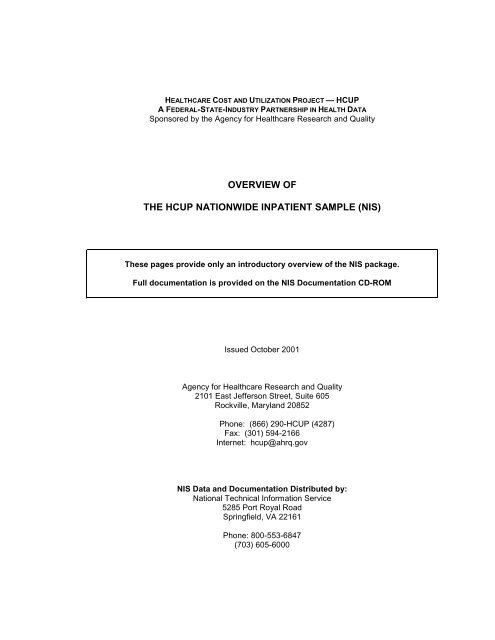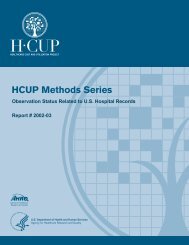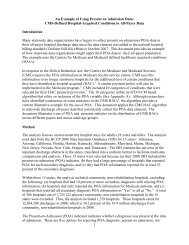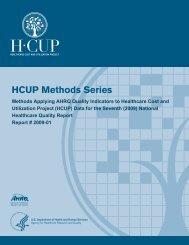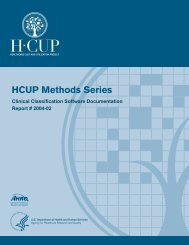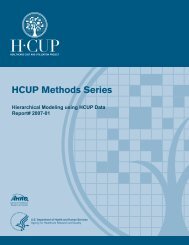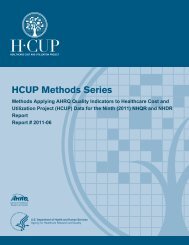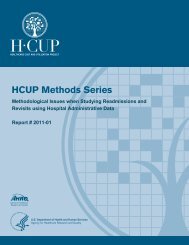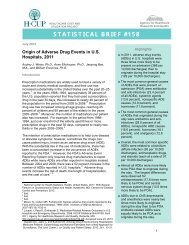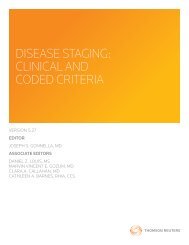nis - HCUP - Agency for Healthcare Research and Quality
nis - HCUP - Agency for Healthcare Research and Quality
nis - HCUP - Agency for Healthcare Research and Quality
You also want an ePaper? Increase the reach of your titles
YUMPU automatically turns print PDFs into web optimized ePapers that Google loves.
HEALTHCARE COST AND UTILIZATION PROJECT — <strong>HCUP</strong>A FEDERAL-STATE-INDUSTRY PARTNERSHIP IN HEALTH DATASponsored by the <strong>Agency</strong> <strong>for</strong> <strong>Healthcare</strong> <strong>Research</strong> <strong>and</strong> <strong>Quality</strong>OVERVIEW OFTHE <strong>HCUP</strong> NATIONWIDE INPATIENT SAMPLE (NIS)These pages provide only an introductory overview of the NIS package.Full documentation is provided on the NIS Documentation CD-ROMIssued October 2001<strong>Agency</strong> <strong>for</strong> <strong>Healthcare</strong> <strong>Research</strong> <strong>and</strong> <strong>Quality</strong>2101 East Jefferson Street, Suite 605Rockville, Maryl<strong>and</strong> 20852Phone: (866) 290-<strong>HCUP</strong> (4287)Fax: (301) 594-2166Internet: hcup@ahrq.govNIS Data <strong>and</strong> Documentation Distributed by:National Technical In<strong>for</strong>mation Service5285 Port Royal RoadSpringfield, VA 22161Phone: 800-553-6847(703) 605-6000
Table of TablesTable 1. Summary of NIS Releases ...............................................................................................5Table 2. Summary of NIS Data Sources, Hospitals <strong>and</strong> Inpatient Stays, 1988-1998 .................... 6Table 3. Data Elements in the NIS Inpatient Core Files, 1998....................................................... 8Table 4. Data Elements in the NIS Hospital Weights Files, 1998 ................................................ 10Table 5. Bed size Categories, by Region ..................................................................................... 12Table 6. NIS Documentation CD-ROM......................................................................................... 14
<strong>HCUP</strong> NATIONWIDE INPATIENT SAMPLE (NIS)SUMMARY OF DATA USE LIMITATIONS***** REMINDER *****All users of the NIS must sign a data use agreement <strong>and</strong> send a copy to AHRQ. †Authorized users of <strong>HCUP</strong> data agree to the following limitations: ‡ŒŒŒŒŒŒŒŒŒŒŒCannot use the data <strong>for</strong> any purpose other than research or aggregate statisticalreporting.Cannot re-release any data to unauthorized users.Cannot identify nor attempt to identify any individual.Cannot link <strong>HCUP</strong> data to data from another source that identifies individuals.Cannot report in<strong>for</strong>mation that could identify individual establishments.Cannot use the data concerning individual establishments <strong>for</strong> commercial orcompetitive purposes involving those establishments.Cannot use the data to determine rights, benefits, or privileges of individualestablishments.Cannot identify nor attempt to identify any establishment when its identity has beenconcealed on the database.Cannot contact establishments included in the data.Cannot attribute to data contributors any conclusions drawn from the data.Must acknowledge the "<strong>Healthcare</strong> Cost <strong>and</strong> Utilization Project, (<strong>HCUP</strong>)" in reports.Any violation of the limitations in the data use agreement is pu<strong>nis</strong>hable under Federal law by afine of up to $10,000 <strong>and</strong> up to 5 years in prison. Violations may also be subject to penaltiesunder State statutes.† A copy of the Data Use Agreement is included on the NIS Documentation CD-ROM <strong>and</strong> isincluded at the end of this document. See next page <strong>for</strong> AHRQ’s address.‡ Specific provisions are detailed in the Data Use Agreement <strong>for</strong> Nationwide Inpatient Sample.1
<strong>HCUP</strong> CONTACT INFORMATIONPlease submit signed data use agreements to <strong>HCUP</strong> at:<strong>Agency</strong> <strong>for</strong> <strong>Healthcare</strong> <strong>Research</strong> <strong>and</strong> <strong>Quality</strong><strong>Healthcare</strong> Cost <strong>and</strong> Utilization Project (<strong>HCUP</strong>)2101 E. Jefferson Street, Suite 605Rockville, MD 20852Phone: (866) 290-<strong>HCUP</strong> (4287)Fax: (301) 594-2166We would like to receive your feedback on the <strong>HCUP</strong> NIS data products.Our Internet address <strong>for</strong> user feedback <strong>and</strong> technical support is:hcup@ahrq.gov2
HEALTHCARE COST AND UTILIZATION PROJECT — <strong>HCUP</strong>A FEDERAL-STATE-INDUSTRY PARTNERSHIP IN HEALTH DATASponsored by the <strong>Agency</strong> <strong>for</strong> <strong>Healthcare</strong> <strong>Research</strong> <strong>and</strong> <strong>Quality</strong>The <strong>Agency</strong> <strong>for</strong> <strong>Healthcare</strong> <strong>Research</strong> <strong>and</strong> <strong>Quality</strong> <strong>and</strong>the staff of the <strong>Healthcare</strong> Cost <strong>and</strong> Utilization Project (<strong>HCUP</strong>) thank you <strong>for</strong>purchasing the <strong>HCUP</strong> Nationwide Inpatient Sample (NIS).<strong>HCUP</strong> Nationwide Inpatient Sample (NIS)ABSTRACTThe Nationwide Inpatient Sample (NIS) is part of the <strong>Healthcare</strong> Cost <strong>and</strong> Utilization Project(<strong>HCUP</strong>), sponsored by the <strong>Agency</strong> <strong>for</strong> <strong>Healthcare</strong> <strong>Research</strong> <strong>and</strong> <strong>Quality</strong> (AHRQ), <strong>for</strong>merly the<strong>Agency</strong> <strong>for</strong> Health Care Policy <strong>and</strong> <strong>Research</strong>.The NIS is a database of hospital inpatient stays. <strong>Research</strong>ers <strong>and</strong> policymakers use the NIS toidentify, track, <strong>and</strong> analyze national trends in health care utilization, access, charges, quality, <strong>and</strong>outcomes.The NIS is the largest all-payer inpatient care database that is publicly available in the UnitedStates, containing data from approximately 7 million hospital stays. The 1998 NIS contains alldischarge data from about 1,000 hospitals located in 22 States, approximating a 20-percentstratified sample of U.S. community hospitals. The NIS is available <strong>for</strong> an 11-year time period,from 1988 to 1998, allowing analysis of trends over time.The NIS is the only national hospital database with charge in<strong>for</strong>mation on all patients, regardlessof payer, including persons covered by Medicare, Medicaid, private insurance, <strong>and</strong> the uninsured.The NIS’s large sample size enables analyses of rare conditions, such as congenital anomalies;uncommon treatments, such as organ transplantation; <strong>and</strong> special patient populations, such aschildren.Inpatient stay records in the NIS include clinical <strong>and</strong> resource use in<strong>for</strong>mation typically availablefrom discharge abstracts. Hospital <strong>and</strong> discharge weights are provided <strong>for</strong> producing nationalestimates. The NIS can be linked to hospital-level data from the American Hospital Association’sAnnual Survey of Hospitals <strong>and</strong> county-level data from the Bureau of Health Professions’ AreaResource File, except in those states that do not allow the release of hospital identifiers.The 1998 NIS differs from previous NIS releases: some data elements were dropped, some wereadded, <strong>for</strong> some data elements the coding was changed, <strong>and</strong> the sampling <strong>and</strong> weightingstrategy was revised to improve the representativeness of the data.Access to the NIS is open to users who sign data use agreements. Uses are limited to research<strong>and</strong> aggregate statistical reporting.3
INTRODUCTION TO THE <strong>HCUP</strong> NATIONWIDE INPATIENT SAMPLE (NIS)OVERVIEW OF NIS DATAThe Nationwide Inpatient Sample contains all-payer data on hospital inpatient stays from Statesparticipating in the <strong>Healthcare</strong> Cost <strong>and</strong> Utilization Project (<strong>HCUP</strong>). Each year of the NISprovides in<strong>for</strong>mation on approximately 5 million to 7 million inpatient stays from about 1,000hospitals. All discharges from sampled hospitals are included in the NIS database.The NIS contains patient-level clinical <strong>and</strong> resource use in<strong>for</strong>mation included in a typicaldischarge abstract. The NIS can be linked directly to hospital-level data from the AmericanHospital Association (AHA) Annual Survey of Hospitals <strong>and</strong> to county-level data from the HealthResources <strong>and</strong> Services Admi<strong>nis</strong>tration Bureau of Health Professions’ Area Resource File (ARF),except in those states that do not allow the release of hospital identifiers.The NIS is designed to approximate a 20-percent sample of U.S. community hospitals, defined bythe AHA to be “all nonfederal, short-term, general, <strong>and</strong> other specialty hospitals, excludinghospital units of institutions.” Included among community hospitals are specialty hospitals suchas obstetrics-gynecology, ear-nose-throat, short-term rehabilitation, orthopedic, <strong>and</strong> pediatricinstitutions. Also included are public hospitals <strong>and</strong> academic medical centers. Excluded areshort-term rehabilitation hospitals (beginning with 1998 data) long-term hospitals, psychiatrichospitals, <strong>and</strong> alcoholism/chemical dependency treatment facilities.This universe of U.S. community hospitals is divided into strata using five hospitalscharacteristics: ownership/control, bed size, teaching status, urban/rural location, <strong>and</strong> U.S.region.The NIS is a stratified probability sample of hospitals in the frame, with sampling probabilitiesproportional to the number of U.S. community hospitals in each stratum. The frame is limited bythe availability of inpatient data from the data sources.In order to improve the representativeness of the NIS, the sampling <strong>and</strong> weighting strategy wasmodified <strong>for</strong> 1998. The full descriptions of this process can be found in the special report onChanges in NIS Sampling <strong>and</strong> Weighting Strategy <strong>for</strong> 1998 which will be available from AHRQ inlate 2001. To facilitate the production of national estimates, both hospital <strong>and</strong> discharge weightsare provided, along with in<strong>for</strong>mation necessary to calculate the variance of estimates. Detailedin<strong>for</strong>mation on the design of the NIS is available in the year-specific special reports on Design ofthe Nationwide Inpatient Sample found on the NIS Documentation CD-ROM.NIS data sets are currently available <strong>for</strong> multiple years, as shown in Table 1. Each release of theNIS includes:C Data in ASCII <strong>for</strong>mat on CD-ROM.C Patient-level hospital discharge abstract data <strong>for</strong> 100 percent of dischargesfrom a sample of hospitals in participating States.C 5 million to 7.1 million inpatient records per year.C 800-1,000 hospitals per year.C Two 10% subsamples of discharges from all NIS hospitals.C Discharge-level weights to calculate national estimates <strong>for</strong> discharges.C Hospital Weights File to produce national estimates <strong>for</strong> hospitals <strong>and</strong> to link theNIS to data from the American Hospital Association Annual Survey ofHospitals.C NIS Documentation <strong>and</strong> tools, also on CD-ROM – including file specifications,programming source code <strong>for</strong> loading ASCII data into SAS <strong>and</strong> SPSS, <strong>and</strong>value labels.4
Table 1. Summary of NIS ReleasesData fromΠ1988-1992Π8 States in 1988Π11 States in 1989-1992Media/<strong>for</strong>matoptionsOn CD-ROM,in ASCII <strong>for</strong>matStructure of Releases5 years of NIS data in a 26-CD set4 CDs per year (one quarter per disk)Two 10% Subsamples of discharges <strong>for</strong>each yearOn magnetic tape,in EBCDIC or SAStransport <strong>for</strong>matEach year sold separatelyΠ1993Π17 statesΠ1994Π17 statesΠ1995Π19 statesΠ1996Π19 statesΠ1997Π22 statesOn CD-ROM,in ASCII <strong>for</strong>mat1 year of data in a 6-CD set, structured <strong>for</strong>use on microcomputersTwo 10% Subsamples of dischargesΠ1998Π22 statesOn CD-ROM,in ASCII <strong>for</strong>mat1 year of data in a 2-CD set, compressedfilesTwo 10% Subsamples of discharges5
NIS Data Sources, Hospitals, And Inpatient StaysTable 2 summarizes the data sources, number of hospitals, <strong>and</strong> number of inpatient stays in NISdata.Table 2. Summary of NIS Data Sources, Hospitals <strong>and</strong> Inpatient Stays, 1988-1998CalendaryearData sourcesNumber ofhospitalsNumber of inpatientstays1988 CA CO FL IL IA MA NJ WA 759 5,265,7561989 AZ CA CO FL IL IA MA NJ PA WA WI(Added AZ, PA, WI)1990 AZ CA CO FL IL IA MA NJ PA WA WI(No change)1991 AZ CA CO FL IL IA MA NJ PA WA WI(No change)1992 AZ CA CO FL IL IA MA NJ PA WA WI(No change)1993 AZ CA CO CT FL IL IA KS MD MA NJ NYOR PA SC WA WI(Added CT, KS, MD, NY, OR, SC)1994 AZ CA CO CT FL IL IA KS MD MA NJ NYOR PA SC WA WI(No change)1995 AZ CA CO CT FL IL IA KS MD MA MO NJNY OR PA SC TN WA WI(Added MO, TN)1996 AZ CA CO CT FL IL IA KS MD MA MO NJNY OR PA SC TN WA WI(No change)1997 AZ CA CO CT FL GA HI IL IA KS MD MAMO NJ NY OR PA SC TN UT WA WI(Added GA, HI, UT)1998 AZ CA CO CT FL GA HI IL IA KS MD MAMO NJ NY OR PA SC TN UT WA WI(No change)882 6,110,064871 6,268,515859 6,156,188856 6,195,744913 6,538,976904 6,385,011938 6,714,935906 6,542,0691,012 7,148,420984 6,827,3506
State-Specific RestrictionsSome data sources that contributed data to the NIS imposed restrictions on the release of certaindata elements or on the number <strong>and</strong> types of hospitals that could be included in the database.Detailed in<strong>for</strong>mation on these state-specific restrictions is available in the special report onSources of NIS Data <strong>and</strong> State-specific Restrictions on the NIS Documentation CD-ROM.Contents of CD-ROM SetThere are two types of files included in the NIS: 1) data files <strong>and</strong> 2) documentation <strong>and</strong> tools files.1) Data Files - three types of ASCII <strong>for</strong>matted data files are included in NIS 1998:Inpatient Core File: This inpatient discharge-level file contains data <strong>for</strong> 100% of thedischarges from a sample of hospitals in participating states.Subsample Inpatient Core Files: Each of these discharge-level files contain all dataelements from the Core File, <strong>for</strong> a 10% subsample of discharges from the NIS; thesecan be combined to create a 20% NIS subsample. These files can be useful <strong>for</strong> testingprograms or validating models.Hospital Weights File: This hospital-level file contains one observation <strong>for</strong> eachhospital included in the NIS <strong>and</strong> contains weights <strong>and</strong> variance estimation dataelements, as well as linkage data elements. The unit of observation is the hospital.The <strong>HCUP</strong> hospital identifier (HOSPID) provides the linkage between the NISInpatient Core files <strong>and</strong> the Hospital Weights file.2) Documentation <strong>and</strong> Tools FilesDocumentation: Complete file documentation, variable notes, <strong>and</strong> summary statisticsare provided in a series of Portable Document Format (*.pdf) files. These files aredetailed in Table 6.SAS source code: Code is included <strong>for</strong> the <strong>for</strong>mat library <strong>for</strong> the variables <strong>and</strong> <strong>for</strong>loading ASCII data into SAS <strong>for</strong>mat.SPSS source code: Code is included <strong>for</strong> the variable library <strong>and</strong> <strong>for</strong> loading ASCIIdata into SPSS <strong>for</strong>mat.Labels: Labels <strong>for</strong> the Clinical Classifications Software (CCS), <strong>for</strong>merly called theClinical Classifications <strong>for</strong> Health Policy <strong>Research</strong> (CCHPR), <strong>and</strong> <strong>for</strong> the Diagnosis-Related Groups (multiple versions).File Specifications: Record layouts <strong>for</strong> all data files.NIS Data ElementsAll releases of the NIS contain two types of data: inpatient stay records <strong>and</strong> hospital in<strong>for</strong>mationwith weights. Table 3 <strong>and</strong> Table 4 identify the data elements that can be found in the inpatientstay <strong>and</strong> hospital weights files, respectively. This is not complete documentation <strong>for</strong> the data;please refer to the NIS Documentation CD-ROM <strong>for</strong> full documentation on all data elements <strong>and</strong><strong>for</strong> the record layout.7
Table 3. Data Elements in the NIS Inpatient Core Files, 1998Note: The 1998 NIS differs from previous NIS releases; some data elements were dropped,some added, <strong>and</strong> <strong>for</strong> some data elements the values were changed.Data elementDescription (numbers in brackets indicate variable coding)AGEAGEDAYAMONTHASOURCEASOURCE_XATYPEAWEEKENDDIEDDISCWTDISCWT10DISPUB92DISPUni<strong>for</strong>mDQTRDRGAge in years at admissionAge in days (coded only when the age in years is less than 1) at admissionAdmission monthAdmission source: (1) ER, (2) another hospital, (3) another facility including longtermcare, (4) court/law en<strong>for</strong>cement, (5) routine/birth/otherAdmission source, as received from data source*Admission type: (1) emergency, (2) urgent, (3) elective, (4) newborn, (6) otherAdmission on weekend: (0) admission on Monday-Friday, (1) admission onSaturday-SundayIndicates in-hospital death: (0) did not die during hospitalization, (1) died duringhospitalizationDischarge weight (on Core file <strong>and</strong> Hospital Weights file)Discharge weight (on 10% subsample file)Disposition of patient (discharge status), UB92 coding: (1) routine, (2) short termhospital, (3) skilled nursing facility, (4) intermediate care, (5) another type offacility, (6) home health care, (7) against medical advice, (8) home IV provider,(20) died in hospital, (40) died at home, (41) died in a medical facility, (42) died,place unknown, (50) Hospice, home, (51) Hospice, medical facilityDisposition of patient (discharge status), uni<strong>for</strong>m coding: (1) routine, (2) transferto short term hospital, (3) other transfers, including skilled nursing facility,intermediate care, <strong>and</strong> another type of facility, (6) home health care, (7) againstmedical advice, (20) died in hospitalDischarge quarterDiagnosis Related Group (DRG) in use on discharge dateDRG10 DRG Version 10 (effective October 1992 - November 1993)DRG18 DRG Version 18 (effective October 2000 - November 2001)DRGVERDSHOSPIDDX1-DX15DXCCS1-DXCCS15FEMALEHOSPIDHOSPSTGrouper version in use on discharge dateHospital number as received from the data sourcePrincipal <strong>and</strong> secondary diagnosesClinical Classifications Software (CCS) category <strong>for</strong> all diagnosesGender of patient: (0) male, (1) female<strong>HCUP</strong> hospital number (links to Hospital Weights file)State postal code <strong>for</strong> hospital (e.g., AZ <strong>for</strong> Arizona)8
Table 3. Data Elements in the NIS Inpatient Core Files, 1998 (Continued)Data elementHOSPSTCOKEYLOSLOS_XMDCDescription (numbers in brackets indicate variable coding)Modified Federal In<strong>for</strong>mation Processing St<strong>and</strong>ards (FIPS) State/county code <strong>for</strong>hospital, links to Area Resource File (available from the Bureau of HealthProfessions, Health Resources <strong>and</strong> Services Admi<strong>nis</strong>tration)Unique record numberLength of stay, editedLength of stay, as received from data sourceMajor Diagnosis Category (MDC) in use on discharge dateMDC10 MDC Version 10 (October 1992 - November 1993)MDC18 MDC Version 18 (effective October 2000 - November 2001)MDID_SNDXNEOMATNPRPAY1PAY1_XPAY2PAY2_XPR1-PR15PRCCS1-PRCCS15PRDAY1-PRDAY15Synthetic attending physician numberNumber of diagnoses coded on the original recordNeonatal/maternal flag: (0) not maternal or neonatal, (1) maternal diagnosis orprocedure, (2) neonatal diagnosis, (3) maternal <strong>and</strong> neonatal on same recordNumber of procedures coded on the original recordExpected primary payer, uni<strong>for</strong>m: (1) Medicare, (2) Medicaid, (3) private includingHMO, (4) self-pay, (5) no charge, (6) otherExpected primary payer, as received from the data source*Expected secondary payer, uni<strong>for</strong>m: (1) Medicare, (2) Medicaid, (3) privateincluding HMO, (4) self-pay, (5) no charge, (6) otherExpected secondary payer, as received from the data source*Principal <strong>and</strong> secondary proceduresClinical Classifications Software (CCS) <strong>for</strong> all proceduresFor each procedure, the number of days from admissionRACE Race includes (1) white, (2) black, (3) Hispanic, (4) Asian or Pacific Isl<strong>and</strong>er, (5)Native American, (6) otherSURGID_STOTCHGTOTCHG_XYEARSynthetic primary surgeon numberTotal charges, editedTotal charges, as received from data sourceCalendar yearZIPINC Median income <strong>for</strong> patient’s ZIP Code: (1) $1-$24,999, (2) $25,000-$34,999, (3)$35,000-$44,999, (4) $45,000 <strong>and</strong> above*For categorical data elements with _X suffix, see Description of Data Elements (on the NIS DocumentationCD-ROM) <strong>for</strong> state-specific coding.9
Table 4. Data Elements in the NIS Hospital Weights Files, 1998Note: The 1998 NIS differs from previous NIS releases; some data elements were dropped,some added, <strong>and</strong> <strong>for</strong> some data elements the values were changed.Data elementAHAIDDISCWTHOSPADDRHOSPCITYHOSPIDHOSPNAMEHOSPSTHOSPWTHOSPZIPHOSP_BEDSIZEDescription (numbers in brackets indicate variable coding)AHA hospital identifier that matches AHA Annual Survey of Hospitals (notavailable <strong>for</strong> all states)Weight to discharges in AHA universeHospital address from AHA Survey (not available <strong>for</strong> all states)Hospital city from AHA Survey (not available <strong>for</strong> all states)<strong>HCUP</strong> hospital number (links to inpatient Core files)Hospital name from AHA Survey (not available <strong>for</strong> all states)Hospital state postal code <strong>for</strong> hospital (e.g., AZ <strong>for</strong> Arizona)Weight to hospitals in AHA universeHospital zip code from AHA Survey (not available <strong>for</strong> all states)Bed size of hospital: (1) small, (2) medium, (3) largeHOSP_CONTROL Control/ownership of hospital: (0) government or private, collapsed category, (1)government, nonfederal, public, (2) private, non-profit, voluntary, (3) private,invest-own, (4) private, collapsed categoryHOSP_LOCATIONHOSP_LOCTEACHHOSP_REGIONHOSP_TEACHIDNUMBERNIS_STRATUMN_DISC_UN_HOSP_US_DISC_US_HOSP_UTOTAL_DISCYEARLocation: (0) rural, (1) urbanLocation/teaching status of hospital: (1) rural, (2) urban non-teaching, (3) urbanteachingRegion of hospital: (1) Northeast, (2) Midwest, (3) South, (4) WestTeaching status of hospital: (0) non-teaching, (1) teachingAHA hospital identifier without the leading 6 (not available <strong>for</strong> all states)Stratum used to sample hospitals; includes geographic region, control,location/teaching status, <strong>and</strong> bed sizeNumber of AHA universe discharges in NIS_STRATUMNumber of AHA universe hospitals in NIS_STRATUMNumber of sample discharges in NIS_STRATUMNumber of sample hospitals in NIS_STRATUMTotal number of discharges from this hospital in the NISCalendar year10
SAMPLING OF HOSPITALS INCLUDED IN THE NISThe hospital universe is defined by all hospitals that were open during any part of each calendaryear <strong>and</strong> were designated as community hospitals in the AHA Annual Survey of Hospitals.For more in<strong>for</strong>mation on how hospitals in the data were mapped to hospitals as defined by theAHA, refer to the special report: <strong>HCUP</strong> Hospital Identifiers. For a list of all data sources, refer to:Sources of NIS Data <strong>and</strong> State-Specific Restrictions. For more detailed descriptions of thesampling design, refer to the year-specific special reports Design of the <strong>HCUP</strong> NationwideInpatient Sample. All reports can be found on the NIS Documentation CD-ROM.Stratification VariablesTo help ensure generalizability, five hospital sampling strata were defined based on hospitalcharacteristics contained in the AHA Annual Survey of Hospitals. The stratification variables are:1. Geographic Region – Northeast, Midwest, West, or South. This is based on the U.S.Census regions.2. Location – urban or rural. A metropolitan statistical area is considered urban.3. Teaching Status – teaching or non-teaching. A hospital is considered to be a teachinghospital if it has an AMA-approved residency program, is a member of the Council ofTeaching Hospitals (COTH) or has a ratio of full-time equivalent interns <strong>and</strong> residentsto beds of .25 or higher.4. Control – government nonfederal (public), private not-<strong>for</strong>-profit (voluntary) or privateinvestor-owned (proprietary). When there were enough hospitals of each type toallow it (southern rural, southern urban non-teaching, <strong>and</strong> western urban nonteaching),hospitals were stratified as public, voluntary, <strong>and</strong> proprietary. For smallerstrata (north central rural <strong>and</strong> western rural hospitals) a collapsed stratification ofpublic versus private was used, with the voluntary <strong>and</strong> proprietary hospitals combinedto <strong>for</strong>m a single ‘private’ category. For all other combinations of region, location <strong>and</strong>teaching status, no stratification based on control was advisable given the number ofhospitals in these cells.5. Bed size – small, medium, or large. Bed size categories are based on hospital beds,<strong>and</strong> are specific to the hospital’s location <strong>and</strong> teaching status, as shown in Table 5.Bed size cutpoints were chosen so that approximately one-third of the hospitals in agiven region <strong>and</strong> location/teaching combination would be in each bed size category(small, medium, or large).Rural hospitals were not split according to teaching status, because rural teaching hospitals wererare.To further ensure geographic representativeness, implicit stratification variables included state<strong>and</strong> three-digit zip code (the first three digits of the hospital’s five digit zip code). The hospitalswere sorted according to these variables prior to systematic r<strong>and</strong>om sampling.11
Table 5. Bed size Categories, by RegionLocation <strong>and</strong>Teaching StatusHospital Bed sizeSmall Medium LargeNORTHEASTRural 1-49 50-99 100+Urban,1-124 125-199 200+non-teachingUrban, teaching 1-249 250-424 425+MIDWESTRural 1-29 30-49 50+Urban,1-74 75-174 175+non-teachingUrban, teaching 1-249 250-374 375+SOUTHRural 1-39 40-74 75+Urban, non-teaching 1-99 100-199 200+Urban, teaching 1-249 250-449 450+WESTRural 1-24 25-44 45+Urban, non-teaching 1-99 100-174 175+Urban, teaching 1-199 200-324 325+12
GETTING STARTEDNIS in<strong>for</strong>mation is provided on two CD-ROMs. The NIS data files are on CD-ROM #1 <strong>and</strong> theNIS documentation <strong>and</strong> tools are on CD-ROM #2.NIS Data FilesIn order to load NIS data onto your PC, you will need 4 gigabytes of space available. Because ofthe size of the files, the data are distributed as self-extracting PKZIP compressed files. Todecompress the data, you should follow these steps:1. Create a directory <strong>for</strong> the NIS on your hard drive.2. Copy the self-extracting data files from the NIS Data Files CD-ROM into the newdirectory.3. Unzip each file by running the corresponding *.exe file.• Type the file name within DOS or click on the name within Windows Explorer.• Edit the name of the "Unzip To Folder" in the WinZip Self-Extractor dialog toselect the desired destination directory <strong>for</strong> the extracted file.• Click on the "Unzip" button.The ASCII data files will then be uncompressed into this directory. After the files areuncompressed, the *.exe files can be deleted.NIS DocumentationNIS documentation files on the Documentation CD-ROM provide important resources <strong>for</strong> theuser. Refer to these resources to underst<strong>and</strong> the structure <strong>and</strong> content of the NIS <strong>and</strong> to aid inusing the NIS. Many of the documentation files are provided in portable document <strong>for</strong>mat (*.pdf)files. Files with the *.pdf extension can be viewed, searched, <strong>and</strong> printed using the AdobeAcrobat Reader.You must have the Adobe Acrobat Reader software on your computer to access the NISdocumentation. If you do not have Adobe Acrobat Reader software on your computer, seethe README.TXT file on NIS Documentation CD-ROM <strong>for</strong> instructions on installing or obtainingthe software.The Acrobat Reader provided on the NIS Documentation CD-ROM is <strong>for</strong> IBM-compatiblemicrocomputers running Microsoft Windows 95 or higher. More in<strong>for</strong>mation <strong>and</strong> AcrobatReader software <strong>for</strong> other plat<strong>for</strong>ms (DOS, Windows 3.1, Macintosh, Sun Systems, etc.) may beobtained free of charge from the Adobe Home Page at http://www.adobe.com/. For furtherassistance in installing <strong>and</strong> running the Adobe Acrobat Reader on your computer plat<strong>for</strong>m,please consult your local support personnel.Table 6 describes the documentation <strong>and</strong> tools files that can be found on the NIS DocumentationCD-ROM <strong>and</strong> illustrates the structure of the directories <strong>and</strong> subdirectories on the CD.13
Table 6. NIS Documentation CD-ROMDirectoryRoot/General In<strong>for</strong>mation/Special Reports/File Specifications/Description of Data Elements/Summary Statistics/SAS Load Programs/SPSS Load ProgramsDescriptionIncludes:• README.TXT file with in<strong>for</strong>mation with introductoryin<strong>for</strong>mation on accessing the NIS documentationIncludes:• Overview of the NIS• Sources of NIS Data <strong>and</strong> State-Specific Restrictions• Data Use Agreement <strong>for</strong> the Nationwide Inpatient SampleIncludes:• Design of the Nationwide Inpatient Sample (year-specificreport)• Calculating Variances using Data from the <strong>HCUP</strong> NationwideInpatient Sample• <strong>HCUP</strong> Coding Practices• <strong>HCUP</strong> <strong>Quality</strong> Control Procedures• <strong>HCUP</strong> Hospital IdentifiersIncludes data set name, number of records, record length, <strong>and</strong> recordlayout. One file per data file (Core, Core Subsample #1, CoreSubsample #2, Hospital Weights)Includes in<strong>for</strong>mation on all NIS variables such as uni<strong>for</strong>m coding <strong>and</strong>state-specific in<strong>for</strong>mation. One file per data type (Core <strong>and</strong> HospitalWeights).Includes summary statistics (means <strong>and</strong> frequencies) on NIS data. Onefile per data file (Core, Core Subsample #1, Core Subsample #2,Hospital Weights)SAS programming code to convert ASCII data files into SAS. One fileper data file (Core, Core Subsample #1, Core Subsample #2, HospitalWeights)SPSS programming code to convert ASCII data files into SPSS. Onefile per data file (Core, Core Subsample #1, Core Subsample #2,Hospital Weights)/<strong>HCUP</strong> Tools_Labels & Formats Includes:• Label file <strong>for</strong> the Clinical Classifications Software (CCSs), acategorization scheme that groups ICD-9-CM diagnosis <strong>and</strong>procedure codes into mutually exclusive categories• Label file <strong>for</strong> Diagnosis Related Groups (DRGs), multiple versions• SAS code to create <strong>for</strong>mat library of variable labels/Adobe Acrobat Reader Adobe Acrobat Reader files (IBM compatible <strong>for</strong> Microsoft Windows 95or higher)14
OTHER <strong>HCUP</strong> PRODUCTSThe AHRQ Home Page on the World Wide Web is a source of in<strong>for</strong>mation about <strong>HCUP</strong>databases <strong>and</strong> aggregate statistics from <strong>HCUP</strong>.The address is: http://www.ahcpr.gov/data/hcup.DataNationwide Inpatient Sample (NIS) releases are available from the National TechnicalIn<strong>for</strong>mation Service (NTIS); call NTIS <strong>for</strong> prices at 800-553-6847 or 703-605-6000. An onlineordering option is available at http://www.ntis.gov/fcpc. All NIS releases are available on CD-ROM; NIS Release 1 may also be purchased on magnetic tape. Order by PB number.NIS, Release 1, 1988-1992 (PB95-503710)NIS, Release 2, 1993 (PB96-501325)NIS, Release 3, 1994 (PB97-500433)NIS, Release 4, 1995 (PB98-500440)NIS, Release 5, 1996 (PB99-500480)NIS, Release 6, 1997 (PB2000-500006)NIS, 1998 (PB2001-500092)State Inpatient Databases (SID) are hospital databases from data organizations participating in<strong>HCUP</strong>. The SID contain the universe of the inpatient discharge abstracts in the participating<strong>HCUP</strong> States, translated into a uni<strong>for</strong>m <strong>for</strong>mat to facilitate multi-State comparisons <strong>and</strong> analyses.Together, the SID encompass about 60 percent of all U.S. community hospital discharges in1998. For more in<strong>for</strong>mation, visit: http://www.ahcpr.gov/data/hcup/hcupsid.htm or call the <strong>HCUP</strong>Central Distributor (see below).State Ambulatory Surgery Databases (SASD) are databases from data organizations inparticipating <strong>HCUP</strong> States, that capture surgeries per<strong>for</strong>med on the same day in which patientsare admitted <strong>and</strong> released. The SASD contain the ambulatory surgery encounter abstracts inparticipating States, translated into a uni<strong>for</strong>m <strong>for</strong>mat to facilitate multi-State comparisons <strong>and</strong>analyses. All of the databases include abstracts from hospital-affiliated ambulatory surgery sites.Some contain the universe of ambulatory surgery encounter abstracts <strong>for</strong> that State, includingrecords from both hospital-affiliated <strong>and</strong> freest<strong>and</strong>ing surgery centers. Composition <strong>and</strong>completeness of data files may vary from State to State. For more in<strong>for</strong>mation, visit:http://www.ahcpr.gov/data/hcup/hcupsasd.htm or call the <strong>HCUP</strong> Central Distributor (see below).Kids’ Inpatient Database (KID) is a unique database of hospital inpatient stays <strong>for</strong> children 18years of age <strong>and</strong> younger. The KID was specifically designed to permit researchers to study abroad range of conditions <strong>and</strong> procedures related to child health issues. KID files <strong>for</strong> 1997 dataare available through the AHRQ-sponsored <strong>HCUP</strong> Central Distributor (contact in<strong>for</strong>mation below).For more in<strong>for</strong>mation, visit: http://www.ahcpr.gov/data/hcup/hcupkid.htm or call the <strong>HCUP</strong> CentralDistributor (see below).15
<strong>HCUP</strong> Central Distributor. Many of the <strong>HCUP</strong> State Partners allow the public release of theState Inpatient Databases (SID) <strong>and</strong> State Ambulatory Surgery Databases (SASD) through theAHRQ-sponsored <strong>HCUP</strong> Central Distributor. In addition, the KID is released through the CentralDistributor. In<strong>for</strong>mation on how to obtain uni<strong>for</strong>mly-<strong>for</strong>matted <strong>HCUP</strong> files from States notparticipating in the <strong>HCUP</strong> Central Distributor is also available from the <strong>HCUP</strong> Central Distributor:<strong>HCUP</strong>net<strong>HCUP</strong> Central DistributorSocial <strong>and</strong> Scientific Systems, Inc.Phone: (866) 556-4287 (toll-free)FAX: (301) 986-8051E-mail: hcup@s-3.com<strong>HCUP</strong>net is a web-based query tool <strong>for</strong> identifying, tracking, analyzing, <strong>and</strong> comparing statisticson hospitals at the national, regional, <strong>and</strong> state level. With <strong>HCUP</strong>net you have easy access tonational statistics <strong>and</strong> trends <strong>and</strong> selected state statistics about hospital stays. <strong>HCUP</strong>net guidesyou step-by-step to obtain the statistics you need. <strong>HCUP</strong>net generates statistics using theNationwide Inpatient Sample (NIS), the Kids’ Inpatient Database (KID), <strong>and</strong> the State InpatientDatabases (SID) <strong>for</strong> those states that have agreed to participate. <strong>HCUP</strong>net can be found at:http://www.ahcpr.gov/data/hcup/hcupnet.htm.Tools<strong>HCUP</strong> <strong>Quality</strong> Indicators (QIs) <strong>and</strong> the new <strong>Healthcare</strong> Improvement Indicators, are clinicalper<strong>for</strong>mance measures <strong>for</strong> use with readily available inpatient data. Methods <strong>and</strong> software <strong>for</strong> the<strong>Healthcare</strong> Improvement Indicators can be downloaded fromhttp://www.ahcpr.gov/data/hcup/qinext.htm.Clinical Classifications Software (CCS), <strong>for</strong>merly known as the Clinical Classifications <strong>for</strong>Health Policy <strong>Research</strong> (CCHPRs), are classification systems that group ICD-9-CM diagnoses<strong>and</strong> procedures into a limited number of clinically meaningful categories. Methods <strong>and</strong> softwarecan be downloaded from http://www.ahrq.gov/data/hcup/ccs.htm.Comorbidity Software assigns variables that identify comorbidities in hospital discharge recordsusing ICD-9-CM diagnosis codes (International Classification of Diseases, Ninth Edition, ClinicalModifications). Methods <strong>and</strong> software can be downloaded fromhttp://www.ahcpr.gov/data/hcup/comorbid.htm.Publications<strong>HCUP</strong> <strong>Research</strong> Notes report aggregate statistics <strong>and</strong> detailed analyses using <strong>HCUP</strong> data. Torequest copies, contact the AHRQ Publications Clearinghouse at (800) 358-9295 or send apostcard to: AHRQ Publications Clearinghouse, P.O. Box 8547, Silver Spring, MD 20907 or visitthe AHRQ Home Page.For in<strong>for</strong>mation on <strong>HCUP</strong> products:Email: hcup@ahrq.govPhone: (301) 594-3075Fax: (301) 594-216616
DATA USE AGREEMENT FOR THE NATIONWIDE INPATIENT SAMPLEThis agreement must be signed by anyone seeking to use data in the Nationwide Inpatient Sample (NIS)maintained by the Center <strong>for</strong> Organization <strong>and</strong> Delivery Studies(CODS), <strong>Agency</strong> <strong>for</strong> <strong>Healthcare</strong> <strong>Research</strong> <strong>and</strong><strong>Quality</strong> (AHRQ) be<strong>for</strong>e access to such data can be granted. All data maintained by CODS/ AHRQ is confidentialor proprietary except data specified <strong>for</strong> restricted access public release, or data authorized by AHRQ <strong>and</strong> theoriginal data source <strong>for</strong> re-release.Under section 924(c) of the Public Health Service Act (42 U.S.C. 299c-3(c)), data that identifies individuals orestablishments collected by the <strong>Agency</strong> <strong>for</strong> <strong>Healthcare</strong> <strong>Research</strong> <strong>and</strong> <strong>Quality</strong> (AHRQ) may be used only <strong>for</strong> thepurpose <strong>for</strong> which they were collected. Data supplied to AHRQ under the auspices of <strong>HCUP</strong> were provided bythe data sources only <strong>for</strong> research, analysis, <strong>and</strong> aggregate statistical reporting.No identification of persons--Any ef<strong>for</strong>t to determine the identity of any person contained in the databases(including but not limited to patients, physicians, <strong>and</strong> other health care providers) or to use the in<strong>for</strong>mation <strong>for</strong> anypurpose other than <strong>for</strong> research, analysis, <strong>and</strong> aggregate statistical reporting would violate the conditions of thisdata use agreement <strong>and</strong> there<strong>for</strong>e the above-referenced AHRQ confidentiality statute. Furthermore, under thestatute, no identifying in<strong>for</strong>mation may be published or released in any way without the consent of the person whosupplied the in<strong>for</strong>mation or who can be identified by the in<strong>for</strong>mation. AHRQ omits from the data set all directpersonal identifiers, as well as characteristics that might lead to identification of persons. It may be possible inrare instances, through complex analysis <strong>and</strong> with outside in<strong>for</strong>mation, to ascertain from the data sets the identityof particular persons. Considerable harm could ensue if this were done. By virtue of this agreement, theundersigned agrees that such attempts will be prohibited <strong>and</strong> that in<strong>for</strong>mation which could identify individualsdirectly or by inference will not be released or published. Because of these restrictions, users of the data mustagree that they will not attempt to contact individuals <strong>for</strong> the purpose of verifying in<strong>for</strong>mation supplied in the <strong>HCUP</strong>databases. Any questions about the data must be referred to AHRQ only.Use of Establishment identifiers--Section 924(c) of the Public Health Service Act (42 U.S.C. 299c-3(c) ) alsorestricts the use of any in<strong>for</strong>mation that allows the identification of establishments to the purpose <strong>for</strong> which thein<strong>for</strong>mation was collected. Permission was obtained from the data sources (state data organizations, hospitalassociations, <strong>and</strong> data consortia) to use the identification of hospitals (when such identification appears in thedata sets) <strong>for</strong> the purpose of conducting research only. Such research purpose includes linking institutionalin<strong>for</strong>mation from outside data sets <strong>for</strong> analysis <strong>and</strong> aggregate statistical reporting. Such purpose does not includethe use of in<strong>for</strong>mation in the data sets concerning individual establishments <strong>for</strong> commercial or competitivepurposes involving those individual establishments, or to determine the rights, benefits, or privileges ofestablishments. Users of the data must not identify establishments directly or by inference in disseminatedmaterial. In addition, users of the data must not contact establishments <strong>for</strong> the purpose of verifying in<strong>for</strong>mationsupplied in the <strong>HCUP</strong> databases. Any questions about the data must be referred to AHRQ only.The undersigned gives the following assurances with respect to the AHRQ data sets.C I will not use nor permit others to use the data in these sets in any way except <strong>for</strong> research, analysis, <strong>and</strong>aggregate statistical reporting;C I will require others in the organization (specified below) who use the data to sign this agreement (specificallyacknowledging their agreement to abide by its terms) <strong>and</strong> will submit those signed agreements to AHRQ;C I will ensure that the data are kept in a secured environment <strong>and</strong> that only authorized users have access to thedata;C I will not release nor permit others to release any in<strong>for</strong>mation that identifies persons, directly or indirectly;C I will not release nor permit others to release the data sets or any part of them to any person who is not amember of the organization (specified below), except with the approval of AHRQ;C I will not attempt to link nor permit others to attempt to link the hospital stay records of persons in this data setwith personally identifiable records from any other source;17 (Revised 11/03/00)
Data Use Agreement <strong>for</strong> <strong>HCUP</strong> Nationwide Inpatient Sample (continued)C I will not attempt to use nor permit others to use the datasets to learn the identity of any person included in anyset;C I will not use nor permit others to use the data concerning individual establishments (1) <strong>for</strong> commercial orcompetitive purposes involving those individual establishments, (2) to determine the rights, benefits, orprivileges of individual establishments nor (3) to report, through any medium, data that could identify, directlyor by inference, individual establishments;C When the identities of establishments are not provided on the data sets, I will not attempt to use nor permitothers to use the data sets to learn the identity of any establishment in the data sets;C I will not contact nor permit others to contact establishments or persons in the data sets to question, verify, ordiscuss data in the <strong>HCUP</strong> databases;C I will indemnify, defend, <strong>and</strong> hold harmless the data sources <strong>and</strong> AHRQ from any or all claims <strong>and</strong> lossesaccruing to any person, organization, or other legal entity as a result of violation of this agreement. Thisprovision applies only to the extent permitted by federal law <strong>and</strong> regulation (i.e., to the extent permitted by 31United States Code Section 1341 (Subtitle II, Chapter 13, Subchapter III, "Limitations on Expending <strong>and</strong>Obligating Amounts."));C I will make no statement nor permit others to make statements indicating or suggesting that interpretationsdrawn are those of data sources or AHRQ;C I will acknowledge in all reports based on these data that the source of the data is the “<strong>Healthcare</strong> Cost <strong>and</strong>Utilization Project (<strong>HCUP</strong>), <strong>Agency</strong> <strong>for</strong> <strong>Healthcare</strong> <strong>Research</strong> <strong>and</strong> <strong>Quality</strong>”.I underst<strong>and</strong> that these assurances are collected <strong>for</strong> the United States <strong>Agency</strong> <strong>for</strong> <strong>Healthcare</strong> <strong>Research</strong> <strong>and</strong><strong>Quality</strong> to require compliance with its statutory confidentiality requirement. My signature indicates my agreementto comply with the above-stated requirements with the knowledge that any violation of this statute is subject to acivil penalty of up to $10,000 under 42 U.S.C. 299c-3(d), <strong>and</strong> that deliberately making a false statement about thisor any matter within the jurisdiction of any department or agency of the Federal Government violates 18 U.S.C.1001 <strong>and</strong> is pu<strong>nis</strong>hable by a fine of up to $10,000 or up to five years in prison. Violators of this agreement mayalso be subject to penalties under state confidentiality statutes that apply to these data <strong>for</strong> particular states.Signed:Date:Print or Type Name:Title:Organization:Address:City: State: Zip code:Phone Number: Fax: E-mail:Note to Purchaser: Shipment of the data product will only be made to the person who signs this data useagreement.18 (Revised 11/03/00)


